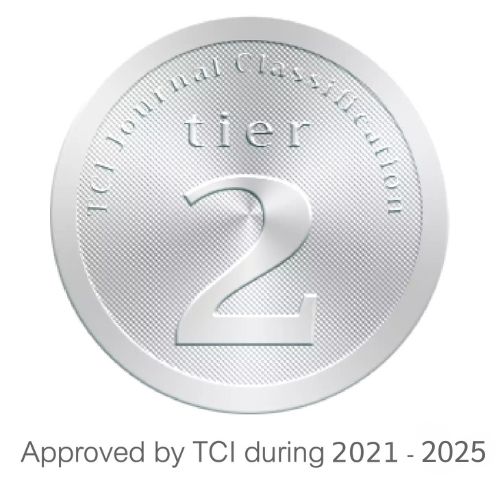เจ้าของธุรกิจคนไทยในสเปนและกลยุทธ์การใช้ความเป็นต่างชาติ
Thai Business Owners in Spain and the Strategic Use of Their Foreignness
Keywords:
คนอพยพเชื้อชาติไทย, ธุรกิจไทย, ความดั้งเดิม, การกําาหนดความแตกต่าง, สเปนAbstract
บทความนี้ศึกษาธุรกิจชาติพันธุ์ของเจ้าของธุรกิจคนไทยในสเปน โดยใช้การสัมภาษณ์กับเจ้าของร้านอาหารไทยและร้านนวดไทยเป็นหลัก อีกทั้งยังมีการใช้ข้อมูลการสัมภาษณ์กับพนักงานในธุรกิจเหล่านั้นรวมถึงคนไทยในชุมชน ผู้วิจัยค้นพบว่าเจ้าของธุรกิจคนไทยในสเปนเชิดชูสถานะ “ความเป็นต่างชาติ” เพื่อความสำเร็จในการทำธุรกิจซึ่งตรงกันข้ามกับผลงานวิจัยในอดีต เจ้าของธุรกิจคนไทยเลือกสร้างและแสดงความเป็นไทยแท้และละทิ้งประโยชน์ที่ได้จากความเป็นกลุ่มชาติพันธุ์ โดยใช้สามกลยุทธ์ดังนี้ 1) ส่งเสริมความเป็นชาตินิยม 2) การจ้างงานคนชาติเดียวกัน และ 3) การใช้ของตกแต่งไทย บทความนี้มีประโยชน์อย่างมากในการเข้าใจเรื่องเชื้อชาติ เผ่าพันธุ์ และการอพยพย้ายถิ่นเนื่องจากทำให้เห็นว่ากลุ่มชาติพันธุ์สามารถได้รับประโยชน์จาก “ความเป็นต่างชาติ” ซึ่งโดยปกติจะถูกใช้เป็นกลไลในการแบ่งแยกผู้อพยพออกจากสังคมหลักReferences
Adib, A. & Guerrier, Y. (2003). The Interlocking of Gender with Nationality, Race, Ethnicityand Class: The Narratives of Women in Hotel Work. Gender, Work and Organization.10(4): 413–432.
Arango, J. (2013). Exceptional in Europe? Spain’s Experience with Immigration and Integration. Washington, DC: Migration Policy Institute.
Barth, F. (1998). Ethnic Groups and Boundaries: The Social Organization of Culture Difference. Illinois: Waveland Press.
Bartkowski, J. & Read, J. (2003). Veiled Submission: Gender, Power, and Identity among Evangelical and Muslim Women in The United States. Qualitative Sociology.26(1): 71–92.
Cebrian, J. (2009). Ethnic Business in Spain. Bruxelles: Migration Education Organization.
Dávila, A. (2012). Latinos, Inc: The Marketing and Making of a People. California: University of California Press.
Department of European Affairs. (2017). Thai population in Spain. Retrieved on April 1, 2019, from http://www.europetouch.in.th/main/NationalityDetail/%E0%B8%AA%E0%B9%80%E0%B8%9B%E0%B8%99=15l25l84l84l58l96l.html
Desiderio, M. V. & Mestres-Domènech, J. (2011). Migrant entrepreneurship in OECD Countries. Paris: Organization for Economic Co-Operation and Development.
Dhingra, P. (2012). Life Behind the Lobby: Indian American Motel Owners and the American Dream. California: Stanford University Press.
Eriksen, T. (2010). Ethnicity and Nationalism: Anthropological Perspectives. 3rd ed. London: Pluto Press.
Espiritu, Y. (1993). Asian American Panethnicity: Bridging Institutions and Identities.Philadelphia: Temple University Press.Goffman, E. (1959). The Presentation of Self in Everyday Life. New York: Doubleday.
Kim, C. (1999). The Racial Triangulation of Asian Americans. Politics & Society. 27(1): 105–138.
Lamont, M. & Fournier, M. (1992). Cultivating Differences: Symbolic Boundaries and the Making of Inequality. Chicago: University of Chicago Press.
Lamont, M. & Molnár, V. (2002). The Study of Boundaries in the Social Sciences. AnnualReview of Sociology. 28(1): 167–195.
Lan, P. (2003). Negotiating Social Boundaries and Private Zones: The Micropolitics of Employing Migrant Domestic Workers. Social Problems. 50(4): 525–549.
Lee, J. (2002). Civility in the city: Blacks, Jews, and Koreans in urban America.Cambridge: Harvard University Press.
Levitt, P. (2005). Building Bridges: What Migration Scholarship and Cultural Sociology have to Say to Each Other. Poetics. 33(1): 49–62.
Lopez-Sala, A. (2013). Managing Uncertainty: Immigration Policies in Spain duringEconomic Recession (2008-2011). Migraciones Internacionales. 7(2): 39–69.
Mababu, R. (2014). The Role of Social Networks in The Creation and Development of Business among African Immigrants in Madrid Area (Spain). Journal of Small Business and Entrepreneurship Development. 2(3 and 4): 27–46.
MacCannell, D. (1976). The Tourist: A New Theory of the Leisure Class. California: University of California Press.
Mata, F. & Pendakur, R. (1999). Immigration, Labor Force Integration and the Pursuit of Self-Employment. International Migration Review. 33(2): 378–402.
Molz, J. (2004). Tasting an Imagined Thailand: Authenticity and Culinary Tourism in Thai Restaurants. In Lucy M. Long (ed.), Culinary Tourism. pp. 53–75. Kentucky: The University Press of Kentucky.
Muller, J. (2008). Us and Them: The Enduring Power of Ethnic Nationalism. Foreign Affairs. 87(2): 18–35.
Nazareno, J. (2015). The Outsourced State: The Retraction of Public Caregiving in America. Ph.D. thesis (Sociology). San Francisco: University of California.
Okamoto, D. (2014). Redefining Race: Asian American Panethnicity and Shifting Ethnic Boundaries. New York: Russell Sage Foundation.
Phelps, J.; Blakar, R.; Carlquist, E.; Nafstad, H. & Rand-Hendriksen, K. (2012). Symbolic Boundaries and Ideology in The Norwegian Multicultural Society: A Longitudinal Study of Public Discourse. Journal of Community and Applied Social Psychology. 22(3): 187–205.
Portes, A. & Zhou, M. (1995). Divergent Destinies: Immigration, Poverty, andEntrepreneurship in The United States. In K. McFate, R. Lawson, and W. J. Wilson (eds.), Poverty, Inequality and the Future of Social Policy: Western States in the New World Order. pp. 489–520.
New York: Russell Sage Foundation.Sherman, R. (2005). Producing the Superior Self: Strategic Comparison and Symbolic Boundaries among Luxury Hotel Workers. Ethnography. 6(2): 131–158.
Sims, J. (2012). Beyond the Stereotype of the “Thai-Bride”: Visibility, Invisibility and Community. In K. Charsley (ed.), Transnational Marriage: New Perspective from Europe and Beyond. pp. 161-174.
New York: Routledge.Smith, R. (2005). Mexican New York: Transnational Lives of New Immigrants. California: University of California Press.
Sohoni, D. & Mendez, J. (2014). Defining Immigrant Newcomers in New Destinations: Symbolic Boundaries in Williamsburg, Virginia. Ethnic and Racial Studies. 37(3): 496–516.
Suksomboon, P. (2008). Remittances and “Social Remittances”: Their Impact on Livelihoods of Thai Women in The Netherlands and Non-Migrants in Thailand. Gender, Technology and Development. 12(3): 461-482.
Webster, N. & Haandrikman, K. (2016). Thai women in Sweden: Victims or Participants?. Social Science Asia. 2(1): 13-29.
Wherry, F. (2012). The Culture of Markets. Cambridge: Polity Press.
Wladyka, D. & Moren-Alegret, R. (2015). Chinese Immigrants in The Sagrada Familia Neighborhood of Barcelona, Spain: Their Socio-Economic Viability and Identity. In R. Iredale and F. Guo (eds.), Handbook of Chinese Migration: Identity and Wellbeing. pp. 238–255.
Cheltenham: Edward Elgar Publishing. Wu, F. (2003). Yellow: Race in America beyond Black and White. New York: Basic Books.
Zhou, M. (2004). Revisiting Ethnic Entrepreneurship: Convergencies, Controversies, and Conceptual Advancements. International Migration Review. 38(3): 1040–1074.








